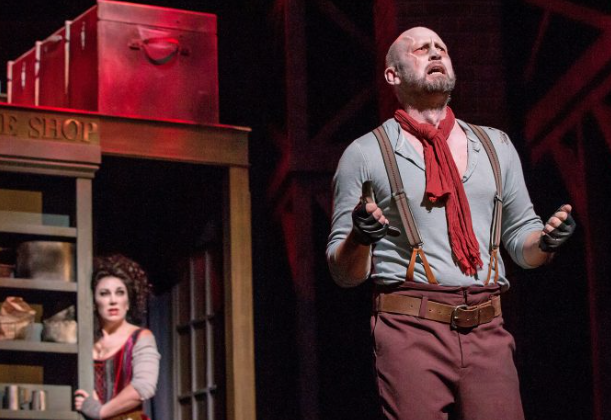Introspection and review by Selwyn Manning. All still photographs by David Rowland.
A ghastly tale of horror and intrigue looms for Wellington and Christchurch theatre-goers as New Zealand Opera sharpens its knives before its Auckland consumers – but beware, this story of Sweeney Todd may compel you to think.
Sweeney Todd is one awful story. And the tale is retold so well by this rendition of Stephen Sondheim’s musical horror, that at times you can almost smell it, how rotten Victorian London was. But is its power to compel dread found in the mirror this story presents?
Introduction to Sweeney:
Many of you will be familiar with the story: how Sweeney Todd was once happy and married to a delightful and true wife, how the couple were blessed by a loved and loving daughter, how a corrupt judge coveted their world, how his class and power was a privilege of his time, how the ugliness of obsession became compulsion, how he convicted Sweeney on a trumped up charge, sentenced him to life as a prisoner of mother England to be served within the penal colony of Australia, and then when the beauty within the Todd family turned vulnerable the judge set out to devour all of that which was left of Sweeney Todd’s world. Some fifteen years later, Sweeney Todd escapes, returns to England and seeks revenge against those who destroyed what he loved.
In a way it’s a brilliant story, the ghastly deeds committed by Sweeney and Mrs Lovett mask the true monster of class and inequality, the abandonment of meritocracy, the privileged’s indifference and consequential loathing for those cast below it. Indeed, Sondheim’s story transports us to an earlier time to when Victorian England was rotten to the core.

Prelude To Sweeney – Masterclass:
On preparing to attend this opera, I chose to wear tidy but casual pants. I donned a nice shirt rather than white shirt-black tie attire, and the jacket was almost unworn but was perhaps more suited to the cool weather outside than the Civic’s special magic. Perhaps, in hindsight, I should confess, it was a little test. Some opera-goers are notorious for being a tad snobby, and Sweeney Todd was too rich to resist. Were Auckland’s elite happy that New Zealand Opera was performing this Sondheim ‘musical’ only to risk broadening the audience demographic?
We had chosen not to enter via the Civic’s red carpet, but rather through the right-hand side entrance. We made for the booking office and were greeted wonderfully as always by New Zealand Opera’s staff. With tickets in hand and having been presented with a fabulously produced and written programme, we sought not to mingle but made for the theatre’s stalls. The ushers were delightful in guiding us to our row, then our seats. We settled in, relaxed, gazed upward and about as we always do when inside the marvelous Civic theatre.
We politely stood up, as is the custom, to let others squeeze passed as allocated seats were sought.
Then, a dreadful moment presented as one very finely suited man of considerable height and an air of boardroom elegance squeezed passed to loom above us. Before realising we were perhaps considered casts of a lesser God, the man paused time to insist, in his patiently expressed but obviously refined vowels, that we were sitting in his seats! “Are you sure,” I replied intoning a suggestion rather than question. “Positive,” he retorted.
As I traversed my mind to consider the scale of probabilities, he beat me to it and snapped: “Show me your tickets!” I reached for my pocket electing to annoy by deploying the Union tactic of a ‘go slow’. But once the evidence was presented I am sad to report that on inspection, it was proven that the ‘person’ who was to become the focus of my societal-comparative-analysis was indeed correct. We had been ushered to the wrong row, the wrong seats, and I had failed to check the bloody tickets.
Needless to say dejection set in before ejection was sought and shamefully it became our lot to squeeze passed the polite-and-the-tolerant and search out our seats with haste before the Civic’s magical shooting star heralded our journey back to acceptability to another time and place.
And transported we were.
The Resurrection and the Performance:

Within seconds of the superb Auckland Philharmonia’s conductor Benjamin Northey instructing his organist to bellow out a most agonising sequence of chords, two things came to mind: Vincent Price, and, how as children, one of my brothers and I used to nick the keys to the church next door, sit on the organ stool, pump the treadle while depressing the lowest note that old Gherty could muster. There rumbling out a diabolical racket, we would smart with devilish grin knowing our mother wouldn’t be too far away to save the community from the horror story score we had conducted. From the first note, I had one foot in Sweeney Todd present and the other in a past which seems too long ago.
Director Stuart Maunder AM has achieved something special here. He has ensured his cast performs to their strengths. And it works. Teddy Tahu Rhodes, with respect to you, from the moment you appeared as a demon among the light you became our Sweeney Todd.
Rhodes’ voice… people if you want to hear what a real baritone sounds like then you have to see and hear this guy perform this role. He makes Caiaphas in JC Superstar sound like a genteel grandfather.
When Rhodes speaks as Sweeney, all before him become captors with a compulsion to listen. And thank you for that, as Sweeney’s message is powerful. In performance, voice has many elements where the unspoken whispers to the inner you. Could it be that Sweeney Todd compels us to consider what kind of character in truth we have become?
It is true that Rhodes channels a horror that lurks within Sweeney, and within this character there is time and space to pause, to consider, to realise cause and effect.
Rhodes’ strength plants Sweeney Todd’s feet firmly on the ground, which choreographs well opposite soprano Antoinette Halloran who is cast as his offsider Mrs Lovett. Halloran is the yang of his yin (or considering the characters, is it the other way around). In any case, Halloran is a master of comic timing and centre-stage presence. And she has to be to make this production of Sweeney Todd work. It is simply due to a well-learned and earned talent that by degrees she allows her audience to sense that perhaps Mrs Lovett’s beguiling charm is but a cloak that conceals a duality – an oscillation between hope and construct, an intention caught between love and greed that morphs into a ghastly heart.
The story has its diversions. The plight of the young potential lovers, Johanna and Anthony Hope (performed superbly by Amelia Berry and James Benjamin Rodgers) is vital so as to accentuate a corruption manifest in the evil Judge Turpin (Phillip Rhodes), the horribly sycophantic Beadle Bamford (Andrew Glover), the tragedy that becomes Tobias Ragg (performed by the marvelous Joel Granger), and the hilarity of arch-crook Pirelli (performed by Robert Tucker). Another special mention: it pays to pay attention to the Beggar Woman (so wonderfully performed by Helen Medlyn) for she holds the key to a very clever flick of the knife.
Once again production designer Roger Kirk has created a marvelous set that anchors, transforms and transports, and yes that summary includes that dreadful barber’s chair.
Prologue to Sweeney:
On exiting the Civic, my man was there standing centre-stage upon the red carpet. He had chosen not to exit but rather juxtapositioned his back to the entrance (perhaps a barrier to the hordes outside). Again he towered above all others and sought to chat, to mingle, and again we squeezed passed with thought.
The freshness of pre-equinox air greeted us, the vibe on the street was joyous. Theatre-goers were well pleased with Sweeney Todd. Lovers lined up to share ice-creams near a shop where Royal Dalton was once sold. On the south-side of Queen Street I felt delighted to realise the decrepit Kerridge Odeon buildings had been demolished before noticing a man to my left of prime working age and inclination sat on a blanket holding a cardboard sign that read: “Can you help me please.” He, like some of the characters in Sweeney Todd, clearly slept rough. But his story was reality not fiction while in truth he shared a commonality as a consequence of indifference, class and inequality. Another rested his back against a Queen Street shop wall, perhaps to take timeout from begging. And my partner said to me (or to herself): “I must always remember to bring along some cash.”
We headed for the Civic Car-park, where at the Town Hall entrance, there exposed to wind and rain, another man lay wrapped up in a blanket and prepared snuggle down to sleep off the cold. We got in our car, exited the car-park, accelerated up Greys Avenue, turned left into Pitt Street, and worked our way passed a young man who lay amid the traffic flowing passed the corner of Karangahape Road. Help was at hand, a group of people had placed him in the recovery position, held his hand and awaited an ambulance’s arrival.
Then, Kingsland-bound, we drove passed where Dick Smith’s used to be, and noticed a slight teenager dressed in the lightest of summertime cloth preparing to earn herself a living for the night, and I thought of how on one-late-Friday-night, at the age of thirteen years four months, Aaron Williams and I shared a half dozen bottles of beer beneath the Southmall railway bridge in Manurewa and waited for the last train to pass. I thought then of how we didn’t realise we had our lifetimes ahead of us. And it took some four days before I could write this review.
Bravo New Zealand Opera, and thank you all especially Stephen Sondheim for Sweeney Todd – for while he became the protagonist for a terrible horror (yes his actions were chosen by the monster of whom he had become) Sweeney was merely a mask to disguise what a society and culture had created.
What: New Zealand Opera.
Performance: Sweeney Todd – the demon barber of Fleet Street.
Auckland dates: September 17, 18, 21, Friday 23, and Saturday 24.
Wellington dates: September 30, October 1, 2, 4, and 5.
Christchurch: October 12, 13, 14, 15 (two performances).
To discover more and purchase tickets, see:
NZOpera.com
First published on Evening Report




